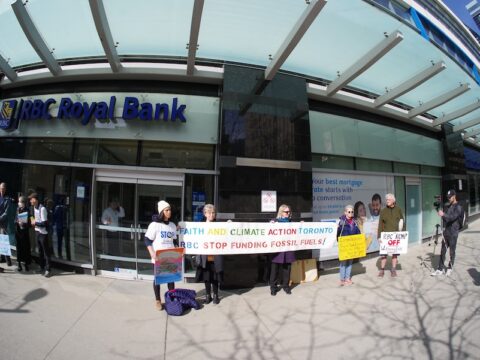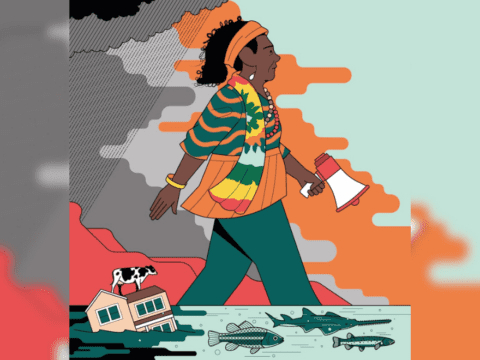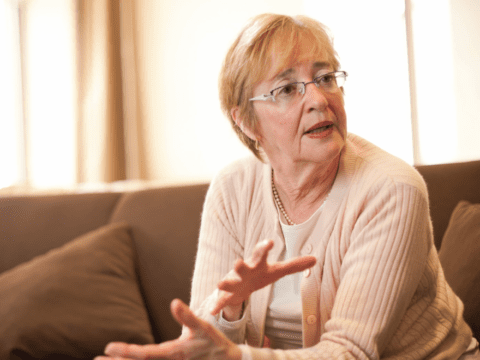At 9:15 p.m. on May 4, 2007, Sharon Schmidt was returning home when the sirens started wailing. Just minutes later, a monstrous tornado slammed into her town of Greensburg, in southwest Kansas. The funnel cloud, nearly three kilometres wide, brought winds that topped 300 km/h, sucking nails out of walls, splintering bricks and shattering glass. Cars cartwheeled over the three-storey Kiowa County Courthouse, leaving streaks of paint on the roof. Then, after 12 minutes of hell, nothing. Only the sound of rain falling down into newly exposed basements. “Okay, this one is really, really bad,” Schmidt remembers saying. “We’re in deep trouble here.”
At dawn, Schmidt could see the tornado’s full wrath. Hydro poles and lumber lay strewn like hay. Century-old trees were uprooted, sheared or punctured by licence plates and kitchen utensils. Navigating the wreckage with nothing more than a pair of flip-flops on her feet, Schmidt found scarcely a roof intact, including the one on her rented home. She later learned that the tornado had picked up her former father-in-law’s four-by-four truck and dropped it back down on top of him. The 77-year-old died in hospital.
In all, the tornado claimed 11 lives in Greensburg. Ninety-five percent of the town was destroyed. Just days later, however, at a standing-room-only meeting under a tent, the town’s leadership committed to rebuilding. However, the new Greensburg would not be a replica of the old. Instead, the town would be reborn as a model green community. And the majority of townspeople, including the Schmidts, embraced the idea.
Three years on, Greensburg is back “stronger and greener,” as the placards outside newly rebuilt homes proclaim. Its transformation from a town whose claim to fame had been “The World’s Largest Hand-Dug Well” to the greenest community in the United States testifies not only to the resilience of its heartland citizenry, but also to the power of environmentalism to cut across ideological, partisan and religious lines, uniting communities in a common cause.
Situated in middle-America’s Tornado Alley between warm and cold air masses, Greensburg was a prime candidate for a killer storm, but a seemingly unlikely candidate for becoming a beacon of environmentalism and sustainability.
Before the tornado struck, Greensburg was dying. As it had all over Kansas, agribusiness had swallowed up family farms. Young people were leaving the community in search of better futures elsewhere. Oil and gas production had exploded in the 1970s and ’80s, but automation in the booster stations meant fewer and fewer jobs. By 2000, per capita income had dropped to US$18,000, and about 12 percent of the population was living below the poverty line, according to the city’s own statistics.
Thomas Frank, author of the 2004 book What’s the Matter with Kansas?, must have had communities like Greensburg in mind when he wrote that the Jayhawk state “is pretty much in a free fall . . . in the early stages of irreversible decay.”
Frank’s book explores the state’s curious shift to the far right in the face of Republican economic policies that have clearly hurt it. Greensburg, like the rest of Kansas, hasn’t voted for a Democratic presidential candidate since 1964, when Lyndon Johnson won in a landslide. In this part of the American heartland, political conservatism and religious conservatism go hand in hand. Battles have raged for decades over gay rights, abortion and the teaching of evolution in schools. Just outside of town, a sign in the undergrowth reads “Try Jesus. He never fails!” Before the tornado, nine churches served a population of 1,400.
Greensburg’s neighbour, Pratt, Kan. might seem like an odd place to start a natural foods co-op, but that’s exactly what Daniel Wallach and his wife, Catherine Hart, did when they moved to the area in 2003. They were unaffected by the tornado but deeply moved by the destruction it wrought — and the possibilities for rebirth it presented. Perhaps being outsiders gave them an advantageous perspective.
Although skeptics likened Wallach to the Emerald City charlatan in The Wizard of Oz, he eventually emerged as one of the principal cheerleaders for the rebirth of Greensburg as a model green community.
Today, Greensburg Greentown, the organization that Wallach founded in the wake of the disaster, helps sell the idea of sustainable rebuilding to homeowners and businesses, and points them to the resources that can make it happen. Among them are the U.S. Department of Agriculture and the Department of Energy, which have sunk millions into various projects. Federal funds have supported the retrofitting of the county courthouse and jail, one of the only structures left standing after the tornado, and the rebuilding of the city hall, the county hospital, the arts centre and the local high school, as well as private and city-owned businesses. All of them now meet the U.S. Green Building Council’s LEED Platinum standards, the country’s highest possible certification for green design.
More recently, the town became the first city in the United States to illuminate its streets with LED street-lights, which are projected to save 70 percent in energy and maintenance costs compared to old sodium-vapour lights. Another standout: the newly erected Greensburg Wind Farm. Owned by John Deere Renewables, it is made up of 10 1.25-megawatt wind turbines and aims to provide the town with 100 percent renewable energy 100 percent of the time.
“FEMAville,” the encampment of government-owned emergency trailers on the south edge of town that housed hundreds of twister-affected families, is now gone. About 250 low-slung ranch houses have been built, about half of them using 40 percent less energy than a typical home before the storm. Schmidt, a co-ordinator at the local mental health centre, lives in one of these new homes — a residence built to green specifications with the help of the Mennonite Disaster Service. It has energy-efficient lighting and heating, and superior insulation in the form of recycled newspaper pulp and insulated concrete form blocks. As well, her south-facing windows are shaded with trees and shrubs. Her kitchen is state of the art, including a low-water-use dishwasher.
Two years ago, farm couple John and Janice Haney, both in their mid- 50s, finished their new home on their century-old farm. “At our age, we really should have built back in town,” John says. “But to be honest with you, it only took us three days after the twister to decide otherwise.”
In some ways, their 2,600-square-foot homestead harkens back to earlier farmhouses. “Our house here is called an earth-bermed home,” Janice says, sounding like a high school science teacher. “We have dirt that is pushed up three-quarters of the way onto the east and west sides of the house, which provides natural insulation. As well, we have a geothermal heating and cooling system. And our pond out back was dug for us to enjoy the wildlife and for our household water to permeate back into the natural water table, where it’s used again.” There are only 36 other houses like the Haneys’ in the nation.
“We can be green without having to build multimillion-dollar facilities,” says Janice. “To me, it doesn’t make any difference whether a building is LEED Platinum or something more traditional like an earth-bermed home. You’re being environmentally friendly just by hanging your clothes out on the line….Out here, I also have this big garden, and I’ve gone back to canning and freezing the food I grow. And it seems like, yeah, we’re reversing back to when my husband’s ancestors settled this land.”
The Haneys raise an interesting point. Whether they realize it or not, the people of Greensburg have embraced some of the values of an earlier time as they create a model community for the future. That’s part of what green living is all about, says Ruben Aronin, director of communications for Global Green, the American arm of Green Cross International. Global Green partners with local governments to establish green building programs.
Says Aronin, “That commitment and love of place is really at the heart of the green and sustainability movement. In a lot of our mega-cities, we don’t necessarily see the interdependence of natural systems. But in the rural heartland, there is a certain connectedness — the espousal of the frugal values that America has always stood for in some of its lore. So it’s rather fitting that the community of Greensburg first rallied around renewal and then embraced green building and renewable energies.”
Something else happened in the wake of that terrible night three springs ago. The disaster presented not only a chance to rebuild what was lost but also an opportunity to make things better.
Observes Daniel Wallach, “It’s powerful that all the different parties have come together to help fulfil this greater vision in the community.”
Wallach often talks about the green movement having “roots and shoots.” “The shoots are the innovative buildings, the LED streetlights and the wind turbines, as well as all of the material stuff, but those are all undergirded by a powerful root system that is from the heart and spirit.” With a little coaxing, environmentalism flourished from those roots when the tornado took away everything else on the surface. It led to personal as well as community transformations.
“I was one of the most ignorant people to green that you would find, and I wanted to stay that way, too,” says Pastor Marvin George of First Baptist Church. The 51-year-old is every inch a southern preacher man. Goatee. Leather sports jacket. Wing-tipped boots. A transplant from Benton, Ark., he has lived in Greensburg with his family since January 2001 — about the same time the U.S. evangelical movement began to flex its considerable lobbying muscle in the name of the environment, asking the pointed question, “What would Jesus drive?”
A self-described “Big-C” conservative, George typifies the transformation that many evangelicals have undergone in the last decade. “[The green movement] reaches far and beyond what my finite mind can understand: sustainability, carbon footprints and all those other things,” he says. “But what finally hit me was that it’s not about bringing a ‘little bit of liberalness’ to town, as some may have thought. It’s about the smart stewardship of resources on this Earth. God provided the plants and trees for us to use — not to be wasteful of.” He continues, leaning forward and grabbing a handful of chin. “It’s not a political issue, you see. It’s not a Christian or non-Christian issue. This is a way-of-life issue.”
Until recently, George drove a Toyota Prius hybrid— something he bought after his big sports utility vehicle was destroyed by the tornado. As well, he made certain First Baptist Church was rebuilt sustainably, right down to the bricks and mortar. He even picked out the light bulbs himself. First Baptist is just one of seven local churches that have been reconstructed.
“I’ll tell you what it’s done for us. It’s given us an ability to reach out to a younger base of people we didn’t have before. The younger ones have been thinking this way for years, you know. So we were able to assimilate them into our congregation. And they responded with, ‘Wow, this church is a really green church, something I want to be a part of.’”
Mayor Bob Dixson has watched his town transform from a dying remnant to a community whose rebirth warranted special mention from President Barack Obama in an address to a joint session of Congress in February 2009. Dixson was in attendance. Back in Greensburg and wearing his customary blue jeans and green dress shirt — the town’s name stitched into the left pocket — he cannot disguise his pride in what his town has accomplished. “There’s something special going on here,” he says, “and many folks can see that. We’ve shown great resiliency.”
Still, Dixson admits, there remains lingering fragility, “emotionally and spiritually.” He acknowledges that “rebuilding sustainable has really been instrumental in the saving of Greensburg.” While new construction has levelled off as a result of the recession, Dixson remains committed to the town’s long-term health. He spends a lot of time travelling across the country, trying to attract green industry. “Given the small scale of our town, given we’re a living laboratory for all things green, it really lends itself to being a platform for small clean technology companies that have good ideas. And with them might come ‘green-collar’ jobs that will keep kids in town after graduation and induce young professionals to settle down and raise families here.”
A clutter of catastrophe is still evident in Greensburg. Once-stately maple trees stand damaged or rotting. Patches of grass, sunburned and low to the ground, lie beside stretches of cracked asphalt. On one derelict house, a frayed American flag still flies, and spray-painted over the peeling paint is the single word “Keep.”
In spring, the late-day sky over Greensburg gives off a strange orange glow. Thunderclouds, black and ominous, aren’t far away as Sharon Schmidt settles into a wooden chair atop her new veranda. The prairie winds whip against her face. “You know, I don’t always like this Hollywood-greeny thing,” she says, her words parcelled out slowly above the din of Bobcat tractors and cement trucks. “I sometimes think I just want my old house back. I want my couch back, you know? I want the high school back, and the gym where we had our prom, and all the kids played basketball and all that. The way things were.”
Still, the town’s green rebirth excites Schmidt. “I’m seeing things go up daily, and it amazes me. It was really quite phenomenal what happened here, and I need to remember that.” She continues to do her part — “the small things,” she says — recycling, turning off the faucet when she’s brushing her teeth and turning off the lights when they’re not in use. “I think there’s much goodness in this.”
Her 19-year-old son, Taylor — the youngest of three children — attended Greensburg’s city council meetings regularly after the storm, volunteered for Greensburg Greentown and helped form Greensburg high school’s first-ever green club. He is now in his first year at Kansas State University, studying foreign relations and leadership, as well as giving tours of the school’s own green-certified facilities.
“When I was growing up in Greensburg, if I’m going to be brutally honest, I couldn’t wait to leave,” he says. “But now, I can’t think of a better place to raise a family and to push for different things….It’s because of our lessons, because of the deep spirit of humanity that has swept through Greensburg that we are who we are today. What we’ve learned, what we’ve gained, what we’ve been immensely blessed with has made all the difference.”
Of course, the world’s biggest hand-dug well will always be there, Taylor adds. But without question, the town’s green redevelopment is “something much larger than that.”
***
This story first appeared in The United Church Observer’s June 2010 issue with the title “Reborn green.”















